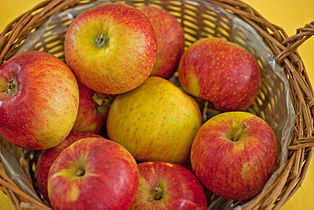Biesterfelder Renette
| Biesterfelder Renette | |
|---|---|

|
|
| Art | Cultivated apple ( Malus domestica ) |
| origin | Biesterfeld Castle ( Lügde ) |
| known since | 1850 |
| ancestry | |
| List of apple varieties | |
The Biesterfelder Renette or Biesterfelder Goldrenette is a variety of the cultivated apple ( Malus domestica ). It is one of the old types of fruit and was found in 1850 as a chance seedling at Biesterfeld Castle near Lügde . Pastor Wilhelm Wilms from Nieheim in Westphalia described it for the first time in 1904 and spread it further. Today this variety is common in orchards all over Germany.
Growth and demands
The tree is strong and vigorous in growth. He is rich and very undemanding. At the location it forms broad crowns with healthy growth. It is characterized by its resistance to scab.
The Biesterfelder Renette loves moist, medium-heavy loamy to sandy loam soils. The strain is prone to cancer on wet soils. Particularly suitable for high altitudes.
Fruit properties
The fruits of the apple are medium to large in size. The shape is spherical to spherical and slightly ribbed.
The green base color changes to a deep yellow with long-term storage with intensely bright cherry-red washed-out stripes on the sunny side. It is covered with numerous small green dots. The calyx is closed and lies in a deep, somewhat irregular, slightly ribbed depression. The stem is short to medium long, in a moderately deep depression.
The flesh is yellowish and very juicy, crumbly and tasty. It is strongly reminiscent of the Gravensteiner , smells and tastes pleasantly sweet-wine and delicately spicy.
The fruits are harvested from mid to late September. This apple is ripe for consumption from September to the end of October; then it becomes crumbly.
literature
- Walter Hartmann , Eckhart Fritz: Color Atlas Old Fruit Varieties , Ulmer Verlag, Stuttgart 2008, ISBN 978-3-8001-5672-6 , p. 41.
Web links
- Index card of the variety in the BUND-Lemgo fruit variety database

